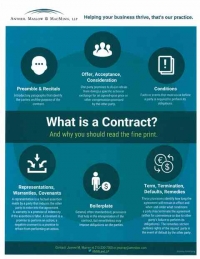5 Common Employment Issues That Can Scuttle the Sale of Your Business
Written by Patricia CollinsThe sale or merger of a business often uncovers employment problems that may scuttle the transaction, or impact the value of the business. In my employment law practice, I’ve seen a pattern of common employment issues businesses face when they are contemplating a transaction, or that emerge during due diligence. Below are the five most common of those issues:
1. Classification of employees as “exempt” or “nonexempt” under federal and applicable state law; and time clock and hourly pay policies, and compliance with federal and state overtime rules;
2. Classification of workers as independent contractors or employees;
3. Evaluation of benefit plans to ensure compliance with plan documents and federal benefits law, and evaluation of policies related to unregulated fringe benefits, such as vacation pay or sick pay;
4. Evaluation of whistleblower and harassment and discrimination complaint procedures;
5. Evaluation of employment contracts and restrictive covenants to ensure that the restrictions included therein will protect the seller and will inure to the benefit of the buyer.
A thorough review of employment policies and procedures and contracts will eliminate trouble in the process. AMM attorneys have experience guiding employers through these issues as part of our clients’ transactions. We can help employers address the crisis when it emerges as part of due diligence. More importantly, we can help employers improve their policies and contracts to maximize value and streamline transactions.
Highly Compensated Employees: Breaking Up Is Hard To Do
Written by Patricia CollinsEmployers work very hard to retain senior, key and talented employees. In the past, we’ve discussed how workplace culture helps to retain talent, and we’ve seen an increased employer focus on those programs. But the truth is that often what causes an employee to stay, and complicates an employee’s exit, are basic compensation programs: competitive salaries, reasonable health insurance, and stock options or other compensation programs that vest over time. These are difficult issues regardless of the reason for the highly compensated employee’s exit.
Of course, any executive is reluctant to walk away from a competitive salary. For executives who resign, this becomes the main bargaining chip with a new employer, and the main area of risk if they are retiring or starting a new business. But, when an executive is involuntarily terminated, our first goal in representing those executives is protecting those benefits. Executives are often eligible for severance programs that will continue their salary for a period. We examine whether the executive is eligible given the circumstances surrounding the termination, and the amount of severance due. Where there is no formal severance program, an executive should consider negotiating a severance package, depending on the circumstances of the termination. For example, most actionable cases of age discrimination occur at these levels, because the more highly compensated employees are also the oldest employees. This may provide some leverage to negotiate a severance.
Health insurance and other benefits are often included in those severance programs. However, if there is no severance program, all employees are entitled to continuation of health insurance under the statute commonly known as “COBRA.” This coverage is available at the employee’s cost unless the employee is terminated for “gross misconduct”. While this coverage is expensive, it does provide a way to continue coverage for up to eighteen months.
The most complicated of these issues, though, is the issue of stock options and other compensation that vests over time. Especially after a long period of employment, executives may find themselves with valuable stock options that vest three or four years in the future. When this executive is terminated, the loss of those unvested options can represent the loss of significant funds. Rarely do such plans allow an employee to vest if he is no longer employed, so there is little room for negotiation on this point. Similarly, when resigning, the executive must consider his timing, calculate what he is leaving “on the table” and perhaps negotiate this loss with a new employer.
AMM has experience navigating these complicated exit issues for executives. We can help a terminated employee protect some of these benefits, and work with resigning employees to navigate an exit in a way that makes economic sense.
Elaine Yandrisevits, an Associate in Antheil Maslow & MacMinn’s Estates and Trusts practice group, will participate as faculty at three upcoming continuing legal education programs this month for the National Business Institute on topics such as estate planning, the probate process and special needs trusts.
The first seminar is on August 13th “Estate Planning: Top 7 Tools to Know” is a comprehensive overview of top estate planning tools, and will outline how to strategically use wills, trusts, advanced directives and more. It is sure to provide valuable techniques that lawyers, financial advisors, trust officers and paralegals can use to provide maximum benefit to clients. Visit www.nbi-sems.com for details and registration.
On August 28th, Yandrisevits will present at The Probate Process from Start to Finish , and on August 29th, Special Needs Trusts in a Nutshell. Details and registration are for these programs are also available on the NBI website.
What is a Contract, and Why You Should Read the Fine Print
Written by Joanne MurrayAs a business owner, you are routinely asked to “sign on the dotted line.” The document could be a purchase order, an equipment lease, or a bill of sale. Often, these documents are in fact contracts that impose obligations on the parties, even if they don’t say “Contract” or “Agreement” at the top of page one. I can’t overstate the importance of knowing what you are signing – i.e., being able to recognize a contract when you see one, as well as understanding the components of a contract and how they impact your business. I often say “think before you sign; review before you renew.”
Over the years, I have worked with many business owners who discover a little too late that they have signed a document that does not align with their intentions and may have costly consequences. For this reason, and under the theory that knowledge is power, I have put together the attached infographic to try to demystify and define the essential elements of a contract. In the coming weeks, I will be writing a series of informational blogs on each of the identified sections of this schematic to offer guidance for business owners as they approach the documents which are so essential to the health and profitability of their enterprise.
Antheil Maslow & MacMinn is pleased to announce that Elaine T. Yandrisevits has joined the firm’s Estate Planning & Administration and Tax practice groups. Elaine is committed to guiding individuals and families through the process of planning for their future needs. Elaine takes the time to develop an understanding of her clients’ goals and priorities and helps them to develop comprehensive estate plans which provide for their families and preserve their wealth in the years to come.
Elaine Yandrisevits practices exclusively in the Estates and Trusts department. She focuses her practice on estate planning, trusts and estate administration and assists with fiduciary litigation matters. Elaine has a great deal of practical experience with special needs trust planning and guardianships. Elaine is a frequent speaker on estate planning, estate administration, and special needs planning for continuing legal education and community organizations.
The Supreme Court Continues To Limit Employees’ Rights Under the Fair Labor Standards Act
Written by Patricia Collins
Reprinted with permission from the June 25th, 2018 issue of The Legal Intelligencer. (c) 2018 ALM Media Properties. Further duplication without permission is prohibited.
The Supreme Court settled a disputed question regarding arbitration clauses as they apply to class and collective actions in Epic Systems Corp. v. Lewis, 584 U.S. ___, (2018). The matter before the Court included three disputes that raised the same issue, but the Court focused on the facts of Ernst &Young LLP v. Morris, a collective action under the Fair Labor Standards Act (“FLSA”), in its opinion. Justice Gorsuch’s opinion for the 5-4 majority professes to focus only on the law, and the opinion chides Justice Ginsberg, writing for the minority, for a focus on policy over precedent. However, both the majority and dissenting opinions reflect a policy dispute: the preference in the law to enforce arbitration clauses versus the historic view of certain employment-related statutes as remedial in nature. One need only reflect that this Court, in Encino Motorcars LLC v. Navarro, rejected the notion that remedial statutes such as the FLSA are subject to any special treatment to know where the Court would land on this particular policy dispute. The Court’s holding that arbitration clauses in employment agreements are enforceable even if they result in a waiver of the right to bring a class or collective action is a blow to employee’s rights under the FLSA. The case also provides a drafting lesson for practitioners.
Morris was an employee of Ernst & Young, and entered into an employment agreement that included an arbitration provision. The arbitration provision stated that it applied to any disputes that might arise between employer and employee; that the arbitrator, chosen by the employee, could grant any relief that could be granted by a court; and that disputes pertaining to different employees would be heard in separate arbitration proceedings.
After his employment ended, Morris sued Ernst & Young, claiming a violation of the FLSA. Specifically, Morris claimed that Ernst & Young misclassified him as exempt under the professional exemption, and that he was therefore owed overtime pay. Morris also sought to state his claim as a “collective action” under the FLSA, as permitted by 29 U.S.C. § 216(b). Predictably, Ernst & Young filed a Motion to Compel Arbitration, and the motion was granted. The Ninth Circuit reversed, and Morris appealed to the Supreme Court.
At issue in the appeal are three statutory schemes: the FLSA “collective action” provision; the National Labor Relations Act, 29 U.S.C. § 151 et seq. (“NLRA”); and the Arbitration Act, 9 U.S.C. § 2. The FLSA permits a “collective action” for violations of the Act. An aggrieved employee may file the action on behalf of himself, and “other employees similarly situated,” provided those other employees provide and file their consent to join the action. The NLRA, relevant to this matter, prohibits an employer from barring employees from engaging in “concerted activity”, as that term is defined in the statute. 29 U.S.C. § 157. The Arbitration Act requires courts to enforce arbitration agreements as written, but, relevant to this matter, includes a “savings clause.” 9 U.S.C. § 2. The savings clause permits a court to refuse to enforce an agreement to arbitrate upon such grounds as exist at law or in equity for the revocation of any contract. Morris argued that the court could not enforce the arbitration agreement under the savings clause of the Arbitration Act. The argument goes that, when applied to this FLSA collective action, the agreement to arbitrate violates the NLRA because it bars the concerted action of pursing claims as a collective action. More generally, the employees argued that the enforcement of an arbitration provision in this context results in a waiver of the right to bring a class or collective action.
Some background informed the Supreme Court’s treatment of these three disputes: in 2010, the National Labor Relations Board expressed the opinion that the validity of agreements to arbitrate “did not involve consideration of the policies of the NLRA.” In 2012, the NLRB expressed a different view, arguing that the NLRA “nullifies” the Arbitration Act in these types of cases. Thereafter, some circuits followed the NLRA’s 2012 view, while the Solicitor General took an opposite view in these cases before the Court. The Supreme Court granted certiori “to clear the confusion.”
However, the Supreme Court’s opinion, authored by Judge Gorsuch for the majority, recognizes little confusion on the issue. The Court held that the Arbitration Act’s savings clause does not permit a court to refuse to enforce an agreement to arbitrate, and that there is no conflict between the NLRA, the FLSA and the Arbitration Act. Indeed, the Court noted that the problem with the employees’ argument was “fundamental”: the savings clause applies only to defenses that apply to any contract, and not to defenses that apply only to arbitration. Morris’ argument was not that his entire employment agreement required revocation on grounds of illegality or unconscionability, but that the arbitration provision required revocation. Because Morris’ gripe was with the arbitration clause itself, and not the entire agreement, says the Supreme Court, the savings clause does not apply.
The Supreme Court also rejected Morris’ argument on the basis that, when confronted with two federal statutes addressing the same topic, the Court is not “at liberty to pick and choose” between them, and must find a way for the statutes to live together. The NLRA, the Court noted, does not mention class or collective actions, and does not refer to the Arbitration Act at all, which was enacted prior to the NLRA.
Judge Gorsuch notes that the employees’ choice not to argue that the FLSA’s “collective action” provisions require the application of the Arbitration Act’s savings clause demonstrates the flaw in the employees’ position. Judge Gorsuch notes that the Supreme Court has already held that the FLSA collective action provisions do not prohibit individualized arbitrations, and that every circuit to consider the question has agreed.
The Court does not stop there: it offers arguments under the predecessor to the NLRA, takes on the issue of deference to agency determinations, and chides the dissent for its focus on policy over precedent. Justice Ginsberg notes in a dissent that the majority’s decision is “egregiously wrong.” In short, neither side recognizes any confusion in the issue, and they arrive at completely different conclusions based on a policy preference. And, practically speaking, both sides are correct about the stakes for employees. As Justice Ginsberg notes: “individually their claims are small and scarcely of a size warranting the expense of seeking redress alone.” For employees, collective actions provide a way to address FLSA violations in a meaningful and cost-effective way. For employers, such actions are expensive and disruptive. The threat of such claims is an incentive to comply scrupulously with the FLSA. The case thus includes a simple but important lesson for those of us who prepare and review employment agreements. The arbitration agreement at issue in the Morris case, for example, included a requirement that disputes pertaining to different employees would be heard in separate arbitration proceedings. Given the Supreme Court’s clear approval of such arrangements, this becomes a powerful clause in an employment agreement. An agreement that eliminates that risk is valuable to employers, a blow to employees’ rights under the FLSA, and now, unquestionably enforceable.
Patricia Collins is a Partner with Antheil Maslow & MacMinn, LLP, based in Doylestown, PA. Her practice focuses primarily on employment, commercial litigation and health care law. To learn more about the firm or Patricia Collins, visit www.ammlaw.com.
There are many reasons why businesses sell. Certainly, the lifecycle of a successful business is often longer than the founder or controlling shareholder’s desire to continue working. In such circumstances, a business owner may wish to extract the reward for years of sweat equity by transitioning to a new ownership group. In other situations, a strategic combination is necessary to fuel continued growth in scope of services or customer reach. Sometimes, an entrepreneur must simply choose between a number of different projects such that divestiture of one opportunity becomes necessary.
Whatever the reason, preparing the business for the sale process can both enhance the value of the transaction and make for a smooth transition. A sophisticated buyer is loath to take on uncertainties, non-ordinary course liabilities or business practices which may give rise to same. A potential seller is wise to get their “house” in order before going to market or even considering discussions with a potential buyer.
Financial Reporting
Financial information is a primary focus of due diligence. Many businesses do not commission audited financial statements on an annual basis. For many more, the annual tax return stands alone as an indication of the value of the business. However, tax returns prepared without an eye on sale often reflect information designed to reflect a reduced tax liability as opposed to demonstrating the value of a going concern. A business owner is wise to consider the assistance of a qualified accounting firm to prepare corporate financial information in a light more suitable for transactional purposes. The actual filing of all applicable returns is a must.
Human Relations & Employment Practices and Policies
Human relations matters are a potential land mine. An employee handbook summarizing policies and procedures is essential. If benefits plans are in place, compliance with all applicable laws will be required if a deal is to be consummated. A current employee census and proof of citizenship or immigration status will be required. Key employees should be subject to employment agreements with assignable restrictive covenants. An acquiror will desire protection against an exodus of management.
Customers and Business Partnerships
Customer relationships and key business agreements should be locked down. An analysis of such agreements in advance with special attention to assignability or change in control provisions is necessary due diligence in any sale. Disclosure to a client or customer may make for a difficult discussion, however, a buyer will want to ensure the continuation of the business relationships prior to commitment. Indemnification obligations and intellectual property rights are certain to be addressed to the extent integral to any customer relationships.
A well-constructed house sells more readily and for greater value than a leaky one on an unstable foundation. Further, a buyer will often require representations and warranties as to the material issues summarized above such that, even after closing, a deficiency can be costly to a seller who thought the transaction was over and the profits safely secured. monetarily impactful. A seller is wise to identify and address deficiencies in advance of sale discussions both to maximize value and make for a smooth, efficient and cost effective transaction.
Healthy Employment Practices Improve Productivity and Workplace Culture
Written by Patricia CollinsI recently had the opportunity to speak at the Central Bucks Chamber of Commerce’s health and wellness event, “Well Employees = Well Business: Best practices and Legal Considerations” along with Megan Duelks, CoE Employee Health Innovations at Johnson & Johnson. Ms. Duelks’ discussion of wellness programs at Johnson & Johnson along with the excellent questions from the attendees highlighted that a workplace with good risk management is also a positive, professional and productive workplace. Good risk management should include three important features, no matter the size of the employer: professionalism, fairness, and a focus on employee performance.
Professionalism means that an employer has in place the important features that protect both employees and employers: a handbook, policies that prohibit discrimination, harassment and retaliation, and a good complaint procedure. Professionalism also requires that complaints are taken seriously, investigated properly and redressed in a meaningful way.
Fairness requires that those policies are followed consistently for each employee, and that exceptions are made for good business reasons.
A focus on employee performance helps to meet these goals. At the seminar, employers were concerned about how to communicate with an employee in crisis. The goal is to help the employee, but protect the employer from unnecessary liability. Having clear policies in place will help to meet these goals. Where the crisis is impacting the employee’s performance, this is where the discussion must start. A focus on performance, which includes anything from attendance to the quality of work, creates a platform for a professional conversation about how to address the issue. An employer is always free to end such a discussion by identifying the resources the employer offers for employees facing personal, family, or health issues.
In my practice at Antheil Maslow & MacMinn, I have assisted many employers to put a program in place that improves culture, manages risk, and creates a framework to address employee crises.
Partner
215-230-7500, ext. 160
eyandrisevits@ammlaw.com
Practice Groups:
Education:
- Villanova University School of Law Graduate Tax Program, LL.M (Taxation) and Estate Planning Certificate: 2015 Drexel University Thomas R. Kline School of Law, Juris Doctor, 2011 University of Delaware, Bachelor of Arts, cum laude (Political Science and History), 2008
Bar Admissions:
- Pennsylvania
- New Jersey
- United States Tax Court
Telecommuting: A reasonable accommodation under the American with Disabilities Act?
Written by Michael KlimplUnder the Americans with Disabilities Act (ADA), an employer must provide reasonable accommodations to an employee who is disabled (as defined under the ADA) and who is otherwise qualified for the position.
An issue frequently faced by employers and addressed by the courts is what constitutes a “reasonable accommodation”?
A federal appeals court recently addressed this matter, where an employee confined to bed because of complications from her pregnancy, requested that she be permitted to work from home or a hospital (telecommuting) for a ten week period. Mosby-Meachem v. Memphis Light, Gas & Water Div. 2018 WL 988895 (6th Cir. February 21, 2018). The employee served as an in-house counsel for a corporation. Her request to telecommute for ten weeks was denied. The company did not at the time of the request have a formal written telecommuting policy-although it did permit telecommuting and permitted the employee on a prior occasion to telecommute. The employee filed suit under the ADA, and a jury awarded her $92,000 in compensatory damages. In affirming the jury’s award, the court held that a “rational jury [under the specific facts of the case,] could find that the employee was a qualified employee, [covered by the ADA] and that working remotely for ten weeks was a reasonable accommodation.” In reaching its conclusion, the court found that sufficient evidence had been presented to the jury to support the employee’s claim that she “could perform the essential functions of her job remotely for ten weeks…” The court rejected the employer’s claim that the written job description for this employee dictated the opposite result because the job description was outdated and did not reflect the employee’s actual work requirements. The court, in affirming the jury verdict, also relied on the fact that the employer did not engage in an “interactive process” with the employee to understand the limitations the employee faced, and what accommodations might be put in place to allow the employee to continue at her job. Instead the employer pre-determined what it intended to do without conversing with the employee. Several lessons can be drawn from this case: First, even if an employer has no telecommuting policy or a policy which does not permit telecommuting, the employer, under a particular set of facts, may be in violation of the ADA if telecommuting would be found to be a reasonable accommodation. Secondly, an employer must engage in an interactive process with an employee to determine what, if any, accommodation might be reasonable under the particular circumstances. This means direct communication between the employer and the employee. An inflexible policy of the employer may end up causing the employer to be in violation of the ADA. Finally, written job descriptions must be reviewed and updated as needed. An outdated or inaccurate job description cannot help an employer and in many instances will be detrimental to an employer seeking to defend against a claim of job discrimination.










